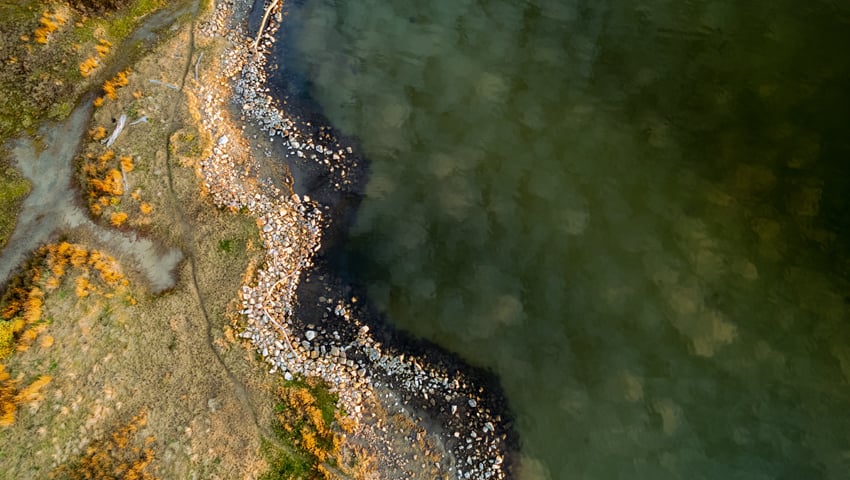A major global study using teabags as a measuring device shows warming temperatures may reduce the amount of carbon stored in wetlands.
The international team of scientists buried 19,000 bags of green tea and rooibos in 180 wetlands across 28 countries to measure the ability for wetlands to hold carbon in their soil, known as wetland carbon sequestration.
While tea bags may seem an unusual instrument to measure this phenomenon, it is a proven proxy method to measure carbon release from soil into the atmosphere. However, this is the first time teabags have been used for a large-scale, long-term study and the tea leaves have revealed which types of wetlands are leaking the most carbon.
RMIT University’s Dr Stacey Trevathan-Tackett led the study published in Environmental Science and Technology as part of an Australian Research Council DECRA Fellowship while at Deakin University.
The global study involved 110 co-authors on the paper, along with many others who helped such as undergraduate students and citizen scientists. Core team members included Dr Martino Malerba and Professor Peter Macreadie from Deakin University and RMIT, Dr Sebastian Kepfer-Rojas from the University of Copenhagen in Denmark and Dr Ika Djukic from The Swiss Federal Institute for Forest, Snow and Landscape Research WSL.
Trevathan-Tackett said, “This is the first long-term study of its kind, using this tea bags method, which will help guide how we can maximise carbon storage in wetlands and help lower emissions globally.
“Changes in carbon sinks can significantly influence global warming – the less carbon decomposed means more carbon stored and less carbon in the atmosphere.”
Reading the tea leaves
Tea bags provide a simple and standardised way to identify how climate, habitat type and soil type influence carbon breakdown rates in wetlands.
At each site, scientists buried between 40 and 80 tea bags about 15 cm underground and collected these at various time intervals over three years, tagging their GPS location. They then measured their remaining organic mass to assess how much carbon had been preserved in the wetlands.
The project used the two types of tea bags (green and rooibos) as measures for different kinds of organic matter found in soils. Green tea consists of organic matter that decomposes easily, whereas rooibos decomposes more slowly. Using both types of tea bags in this project enabled the researchers to gain a more comprehensive picture of the wetlands’ capacity for carbon storage.
“This data shows us how we can maximise carbon storage in wetlands globally,” Trevathan-Tackett said.
The findings
The team studied the effect of temperature in two ways: using local weather station data for each site and comparing differences in climate regions.
“Generally, warmer temperatures led to increased decay of organic matter, which translates to reduced carbon preservation in soil,” Trevathan-Tackett said.
The two tea types acted differently with increasing temperature.
Trevathan-Tackett said, “For the harder to degrade rooibos tea, it didn’t matter where it was – higher temperature always led to more decay, which indicates that types of carbon we’d typically expect to see last longer in the soil were vulnerable to higher temperatures.
“With increasing temperatures, the green tea bags decayed at different rates depending on the type of wetland – it was faster in freshwater wetlands but slower in mangrove and seagrass wetlands.
“Increasing temperatures may also help boost carbon production and storage in plants, which could help offset carbon losses in wetlands due to warmer weather, but this warrants further investigation with future studies.”
Freshwater wetlands and tidal marshes had the highest tea mass remaining, indicating a greater potential for carbon storage in these ecosystems.
The study’s findings are helping piece together the puzzle of wetland carbon sequestration on a global scale. Within the terrestrial TeaComposition initiative led by Dr Ika Djukic, information on litter decomposition has been collected at about 500 sites worldwide resulting in several peer-review publications.
Djukic said, “Applying the common metric across aquatic, wetland, marine and terrestrial ecosystems allows for a conceptual comparison and understanding of key drivers involved in the control of global litter carbon turnover.
“Now that we are starting to get a better understanding of which environments are storing more carbon than others, we can use this information to ensure we protect these areas from environmental or land-use change.”
Next steps
The researchers will combine the data from this project with data from similar studies of land-based carbon sinks, including forests, to inform designs of predictive global models.
